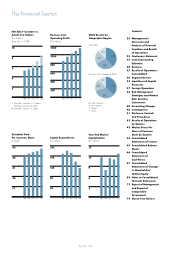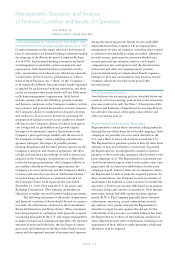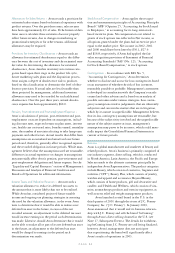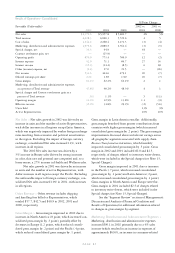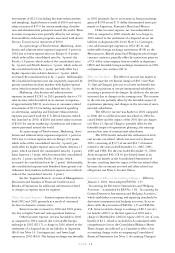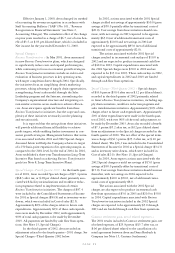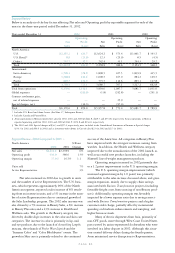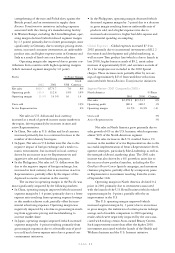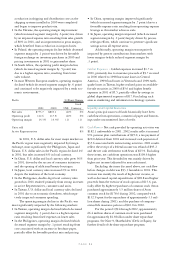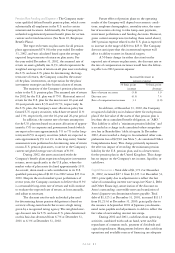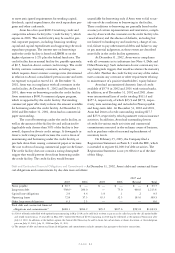Avon 2001 Annual Report Download - page 2
Download and view the complete annual report
Please find page 2 of the 2001 Avon annual report below. You can navigate through the pages in the report by either clicking on the pages listed below, or by using the keyword search tool below to find specific information within the annual report.
PAGE 25
Management’s Discussion and Analysis
of Financial Condition and Results of Operations
Avon Products, Inc.
Dollars in millions, except share data
Cautionary Statement for Purposes of the “Safe Harbor” State-
ment Under the Private Securities Litigation Reform Act of 1995
Certain statements in this report which are not historical
facts or information are forward-looking statements within
the meaning of the Private Securities Litigation Reform
Act of 1995. Such forward-looking statements are based
on management’s reasonable current assumptions and
expectations. Such forward-looking statements involve
risks, uncertainties and other factors, which may cause the
actual results, levels of activity, performance or achieve-
ment of Avon Products, Inc. (“Avon” or the “Company”)
to be materially different from any future results expressed
or implied by such forward-looking statements, and there
can be no assurance that actual results will not differ mate-
rially from management’s expectations. Such factors
include, among others, the following: general economic
and business conditions in the Company’s markets, includ-
ing economic and political uncertainties in Latin America;
the Company’s ability to implement its business strategy
and its Business Transformation initiatives, including the
integration of similar activities across markets to achieve
efficiencies; the Company’s ability to achieve anticipated
cost savings and its profitability and growth targets;
the impact of substantial currency fluctuations in the
Company’s principal foreign markets and the success of
the Company’s foreign currency hedging and risk man-
agement strategies; the impact of possible pension
funding obligations and increased pension expense on the
Company’s cash flow and results of operations; the effect
of legal and regulatory proceedings, as well as restrictions
imposed on the Company, its operations or its Represen-
tatives by foreign governments; the Company’s ability to
successfully identify new business opportunities; the
Company’s access to financing; and the Company’s ability
to attract and retain key executives. Additional informa-
tion identifying such factors is contained in Item 1 of
the Company’s Form 10-K report for the year ended
December 31, 2002, filed with the U.S. Securities and
Exchange Commission. The Company undertakes no
obligation to update any such forward-looking statements.
The following discussion of the results of operations
and financial condition of Avon should be read in conjunc-
tion with the information contained in the Consolidated
Financial Statements and Notes thereto. These statements
have been prepared in conformity with generally accepted
accounting principles in the U.S. and require management
to make estimates and assumptions that affect the reported
amounts of assets and liabilities, the disclosure of contin-
gent assets and liabilities at the date of the financial state-
ments and the reported amounts of revenues and expenses
during the reporting period. Actual results could differ
materially from those estimates. On an ongoing basis,
management reviews its estimates, including those related
to allowances for doubtful accounts receivable, allowances
for sales returns, provisions for inventory obsolescence,
income taxes and tax valuation reserves, stock-based
compensation, loss contingencies and the determination
of discount and other rate assumptions for pension,
post-retirement and post-employment benefit expenses.
Changes in facts and circumstances may result in revised
estimates, which are recorded in the period they
become known.
Critical Accounting Estimates
Avon believes the accounting policies described below rep-
resent its critical accounting policies due to the estimation
processes involved in each. See Note 1, Description of the
Business and Summary of Significant Accounting Policies,
for a detailed discussion of the application of these and
other accounting policies.
Allowances for Doubtful Accounts Receivable >
Representatives contact their customers, selling primarily
through the use of brochures for each sales campaign. Sales
campaigns are generally for a two-week duration in the
U.S. and a three to four week duration outside the U.S.
The Representative purchases products directly from Avon
and may or may not sell them to an end user. In general,
the Representative, an independent contractor, remits a
payment to Avon each sales campaign, which relates to the
prior campaign cycle. The Representative is generally pre-
cluded from submitting an order for the current sales cam-
paign until the accounts receivable balance for the prior
campaign is paid; however, there are circumstances where
the Representative fails to make the required payment. In
these circumstances, the Company records an estimate of
an allowance for doubtful accounts on those receivable bal-
ances that it believes are uncollectible based on an analysis
of historical data and current circumstances. Over the past
three years, annual bad debt expense has been approxi-
mately $100.0. The Company generally has no detailed
information concerning, or any communication with,
any end user of its product beyond the Representative.
Avon has no legal recourse against the end user for the
collectibility of any accounts receivable balances due from
the Representative to Avon. If the financial condition of
Avon’s Representatives were to deteriorate, resulting in an
impairment of their ability to make payments, additional
allowances may be required.

